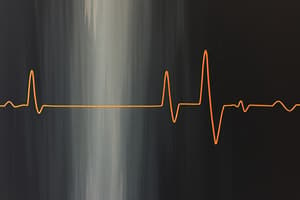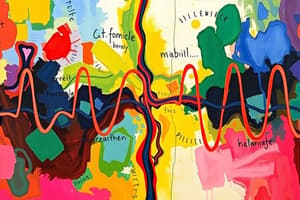Podcast
Questions and Answers
What is emphasized as critical to ensure that a discovery is not lost?
What is emphasized as critical to ensure that a discovery is not lost?
- Immediate publication of findings
- Collaboration with other researchers
- In-depth pursuit to provide context (correct)
- Utilization of advanced technology
What type of current is specifically measured in Hodgkin and Huxley's series of papers?
What type of current is specifically measured in Hodgkin and Huxley's series of papers?
- Electron flow in semiconductors
- Capacitance in neural synapses
- Thermal conductivity of neural tissues
- Membrane conductance of sodium and potassium ions (correct)
Which of the following aspects is NOT mentioned in the summary of Hodgkin and Huxley's work?
Which of the following aspects is NOT mentioned in the summary of Hodgkin and Huxley's work?
- A series of five research papers
- The application of their findings to nerve conduction
- Theoretical foundations prior to their research
- The number of components in membrane conductance (correct)
In what year were Hodgkin and Huxley's key research papers published?
In what year were Hodgkin and Huxley's key research papers published?
What is one outcome suggested by Andrew Huxley's statement regarding discoveries?
What is one outcome suggested by Andrew Huxley's statement regarding discoveries?
What occurs during the initial phase of depolarization according to the provided information?
What occurs during the initial phase of depolarization according to the provided information?
How does temperature affect ionic current according to the content?
How does temperature affect ionic current according to the content?
What happens to the ionic current at a depolarization of 110 mV?
What happens to the ionic current at a depolarization of 110 mV?
Which of the following describes the effect of choline on ionic currents?
Which of the following describes the effect of choline on ionic currents?
The compensated feedback in voltage clamping is intended to reduce what?
The compensated feedback in voltage clamping is intended to reduce what?
What is the primary cause of the rising phase of the action potential?
What is the primary cause of the rising phase of the action potential?
What effect does isotonic choline sea water have on the resting potential?
What effect does isotonic choline sea water have on the resting potential?
What is the relationship between ionic current and membrane potential?
What is the relationship between ionic current and membrane potential?
What was the primary focus of Hodgkin and Huxley's series of papers?
What was the primary focus of Hodgkin and Huxley's series of papers?
What did the Nernst equation determine in relation to ion concentrations?
What did the Nernst equation determine in relation to ion concentrations?
What was a notable result from Paper 1 of Hodgkin and Huxley's research?
What was a notable result from Paper 1 of Hodgkin and Huxley's research?
Which hypothesis proposed the dissociation of salts into ions?
Which hypothesis proposed the dissociation of salts into ions?
What experimental setup was used in Paper 1 to measure membrane current?
What experimental setup was used in Paper 1 to measure membrane current?
How did Hodgkin and Huxley determine the threshold for action potential generation?
How did Hodgkin and Huxley determine the threshold for action potential generation?
What key concept was outlined in the Bernstein hypothesis?
What key concept was outlined in the Bernstein hypothesis?
What does the inactivation process during action potentials involve?
What does the inactivation process during action potentials involve?
What characterizes the late effects of a maintained depolarization?
What characterizes the late effects of a maintained depolarization?
Which channels are discussed in relation to the action potential in the paper?
Which channels are discussed in relation to the action potential in the paper?
What major conclusion is drawn from the responses of the isolated giant axon of Loligo?
What major conclusion is drawn from the responses of the isolated giant axon of Loligo?
According to the findings, which aspect did NOT show good agreement?
According to the findings, which aspect did NOT show good agreement?
What does the theory predict about a direct current's ability to excite?
What does the theory predict about a direct current's ability to excite?
Which phenomenon related to action potentials is characterized by threshold and response?
Which phenomenon related to action potentials is characterized by threshold and response?
What does the simplest equation concerning membrane action potentials fail to consider?
What does the simplest equation concerning membrane action potentials fail to consider?
What type of changes occurred in sodium and potassium permeability during the action potential?
What type of changes occurred in sodium and potassium permeability during the action potential?
What is the relationship between total ionic current and individual ionic currents?
What is the relationship between total ionic current and individual ionic currents?
How does sodium conductance behave during depolarization?
How does sodium conductance behave during depolarization?
What characterizes the conductance curve of potassium compared to sodium?
What characterizes the conductance curve of potassium compared to sodium?
What occurs when sodium is substituted with choline in the experimental setup?
What occurs when sodium is substituted with choline in the experimental setup?
What is the aim of the second paper regarding sodium conductance?
What is the aim of the second paper regarding sodium conductance?
What is indicated by a quick increase then decrease in sodium conductance during fiber depolarization and repolarization?
What is indicated by a quick increase then decrease in sodium conductance during fiber depolarization and repolarization?
Which of the following statements correctly describes the permeability of ions?
Which of the following statements correctly describes the permeability of ions?
What was a significant gap identified in previous experiments regarding sodium conductance?
What was a significant gap identified in previous experiments regarding sodium conductance?
Flashcards
Depolarization
Depolarization
The change in membrane potential from a negative resting state to a more positive value, typically caused by an influx of sodium ions.
Inward and Outward Currents During Depolarization
Inward and Outward Currents During Depolarization
The inward current during depolarization is initially driven by sodium ions, followed by an outward current. This pattern contributes to the rising phase of the action potential.
Voltage Clamp
Voltage Clamp
A technique used to measure ionic currents through the cell membrane by controlling the membrane potential at a desired value.
Effect of Sodium Replacement on Inward Current
Effect of Sodium Replacement on Inward Current
Signup and view all the flashcards
Depolarization and Sodium Permeability
Depolarization and Sodium Permeability
Signup and view all the flashcards
Relationship between Ionic Current and Membrane Potential
Relationship between Ionic Current and Membrane Potential
Signup and view all the flashcards
Temperature Sensitivity of Ionic Currents
Temperature Sensitivity of Ionic Currents
Signup and view all the flashcards
Compensated Feedback
Compensated Feedback
Signup and view all the flashcards
Slow Recovery
Slow Recovery
Signup and view all the flashcards
Refractory Condition
Refractory Condition
Signup and view all the flashcards
Maintained Depolarization
Maintained Depolarization
Signup and view all the flashcards
Types of Ion Channels
Types of Ion Channels
Signup and view all the flashcards
Voltage-Dependent Open Probability
Voltage-Dependent Open Probability
Signup and view all the flashcards
Ionic Permeability and Nerve Signals
Ionic Permeability and Nerve Signals
Signup and view all the flashcards
Hodgkin-Huxley Model of Nerve Conduction
Hodgkin-Huxley Model of Nerve Conduction
Signup and view all the flashcards
Total Ionic Current
Total Ionic Current
Signup and view all the flashcards
Time Course of Permeability
Time Course of Permeability
Signup and view all the flashcards
Sodium Conductance
Sodium Conductance
Signup and view all the flashcards
Potassium Conductance
Potassium Conductance
Signup and view all the flashcards
Combined Conductance at Depolarization
Combined Conductance at Depolarization
Signup and view all the flashcards
Independent Ion Movement
Independent Ion Movement
Signup and view all the flashcards
Hodgkin-Huxley Experiment: Paper 3
Hodgkin-Huxley Experiment: Paper 3
Signup and view all the flashcards
Hodgkin-Huxley Experiment: Paper 4
Hodgkin-Huxley Experiment: Paper 4
Signup and view all the flashcards
Scientific Research without Context
Scientific Research without Context
Signup and view all the flashcards
Hodgkin and Huxley's Papers
Hodgkin and Huxley's Papers
Signup and view all the flashcards
Sodium Current
Sodium Current
Signup and view all the flashcards
Potassium Current
Potassium Current
Signup and view all the flashcards
Membrane Potential
Membrane Potential
Signup and view all the flashcards
Action Potential
Action Potential
Signup and view all the flashcards
Threshold Potential
Threshold Potential
Signup and view all the flashcards
Ionic Current
Ionic Current
Signup and view all the flashcards
Permeability
Permeability
Signup and view all the flashcards
Ionic Conductance
Ionic Conductance
Signup and view all the flashcards
Study Notes
Hodgkin and Huxley (1952) Study Notes
- Hodgkin and Huxley's research focused on the giant axon of the squid.
- The research aimed to understand the electrical properties of nerve cells.
- The study involved a series of five papers.
- Early theories before Hodgkin and Huxley were about osmosis, ion dissociation, and dilution laws.
- Nernst's equation (1897) calculated the potential difference across a membrane.
- Bernstein's membrane theory (1902) proposed the existence of membranes.
- Experimental neurophysiology began in the 1930s.
- Hodgkin and Huxley's experiments measured the behavior of nerve membranes.
- The experiments measured sodium and potassium currents. This helps determine the permeability of membrane to these ions.
- These currents, along with sodium and potassium concentration changes, can create alterations in potential.
Paper 1
- Aim: To measure current-voltage relations in the giant axon membrane.
- Method: Two silver electrodes, a guard system, and a feedback amplifier controlled membrane potential.
- Result: All-or-nothing action potential.
- The potential measured reached 100 mV when stimulated with a brief shock.
Paper 2
- Aim: Determine the currents carried by sodium and potassium through the membrane.
- Inward currents = sodium ions.
- Inward currents contribute to action potentials' rising phase.
- Experiments used isotonic Choline sea water.
- Results: Initial inward currents from 10 to 100 mV depolarisation were reversed with Choline replacements.
- Sodium permeability increased with depolarization.
- Sodium current + Potassium current = Total Ionic current.
- Sodium and Potassium conductance increase and decline exponentially.
Paper 3
- Aim: investigate components of membrane conductance with sudden potential changes.
- Method: Shortened depolarisation duration.
- Method used Choline.
- Results: When sodium was replaced by Choline, repolarisation tail disappeared.
- Results show voltage changed according to the pulse input to the amplifier.
Paper 4
- Aim: Understand the dual effect of membrane potential on sodium conductance.
- Previous experiments lacked info on the rate of repolarization.
- The study explored inactivation.
- Early effects were rapid increase in sodium conductance during depolarization and decrease during repolarization.
- Late effects of depolarisation were slow onset of inactive condition and slow recovery of repolarization.
Paper 5
- Aim: Describe quantitatively the membrane current and its connection to conduction and excitation.
- This paper combined previous results into mathematical equations.
- Three types of channels - Sodium, Potassium and Leakage - were distinguished.
- Voltage dependence of channel behaviour was explored.
- Major conclusions: alterations in sodium and potassium permeability are due to membrane potential changes.
- Mathematical models were created for action potential form, amplitude, velocity.
Studying That Suits You
Use AI to generate personalized quizzes and flashcards to suit your learning preferences.




